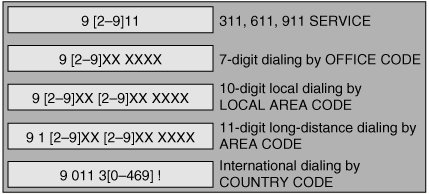
When creating route patterns, you can use the "@" wildcard to represent all the routes defined in the North American Numbering Plan (NANP). Although this is a simple way to provide PSTN access to your internal users, you might be providing far more access than you intend. As shown in Figure 11-1, the NANP includes high-expense patterns such as international dialing access, service numbers (such as 411), and 900 numbers. You can assign route filters to route patterns with the @ route pattern to help reduce the danger that full access to the NANP provides. You can accomplish this reduction by filtering what is included in the @ (or 9.@) route pattern.
Figure 11-1. @ Route Pattern Without Route Filters

When using the 9.@ route pattern, Cisco CallManager recognizes that dialing is complete when the user dials 1 + 10 digits (signifying long-distance dialing) or just dials 10 digits (local area codes without the 1). If the number dialed does not begin with a 1, Cisco CallManager considers it a local area code and assumes that dialing is complete after 10 digits.
In an area where seven digits are dialed for local numbers, Cisco CallManager cannot recognize which office exchange codes (NXXs) to use for routing unless you specifically code them as route patterns.
NXX is the central office (CO) exchange code, which consists of three digits that designate a particular CO or a block of 10,000 subscriber lines. N is any digit between 2 and 9, and X is any digit between 0 and 9.
Generally, telephone company service providers arrange many NXXs in a given area code contiguously where you can use route pattern wildcards to assist in your configuration. Coding these individual route patterns for NXXs can be extremely difficult. You can use a route filter to simplify this procedure.
A route filter called seven-digit dialing is always preconfigured in Cisco CallManager. You should assign this route filter to any 9.@ route pattern in an area that uses seven-digit dialing. This route filter removes all local area codes. If a dialed number does not begin with a 1, then it is a seven-digit number, and Cisco CallManager considers dialing complete after seven digits. This situation requires you to configure local area codes specifically as separate route patterns. Doing so is generally not an issue because the number of area codes in a geographical region is usually small.
Route filters are only used with the @ route pattern and are not necessary if you have configured a robust dial plan (that does not use the @ route pattern).
Route Filter Tags
You can design and configure route filters using a number of predefined tags in the Cisco CallManager CCMAdmin web utility. Table 11-1 provides a list of tags available to you when implementing route filters.
Table 11-1. Cisco CallManager Route Filter Tags